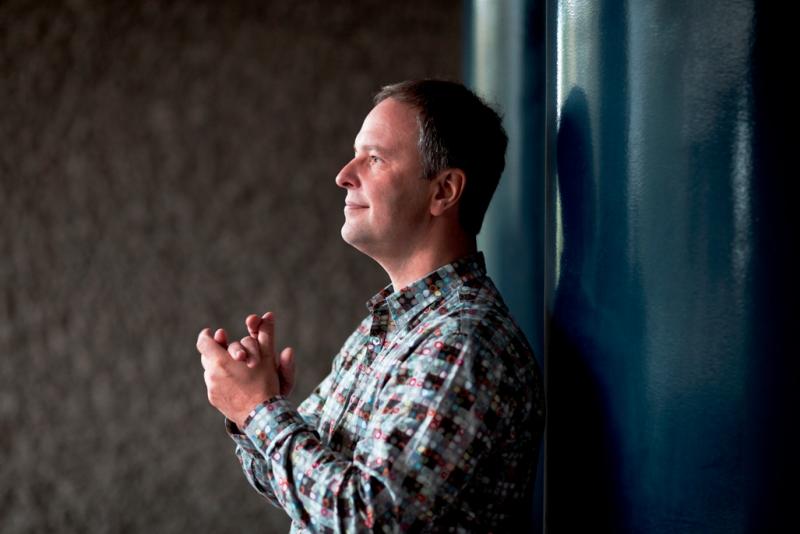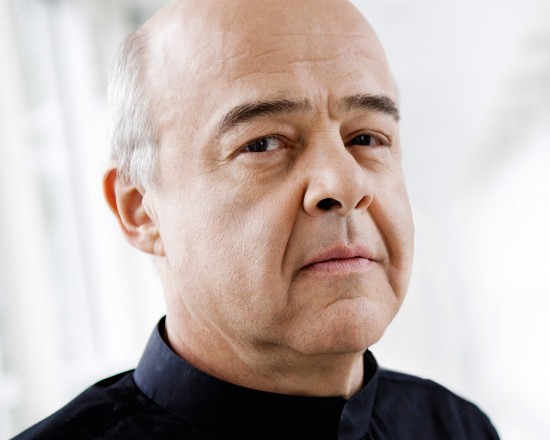Toradze, BBCSO, Oramo, Barbican | reviews, news & interviews
Toradze, BBCSO, Oramo, Barbican
Toradze, BBCSO, Oramo, Barbican
Hyperaesthesia runs riot as febrile 1920s scores flank a colossal Nielsen masterpiece

It was melody versus the machine last night as Sakari Oramo’s six voyages around the Nielsen symphonies with the BBC Symphony Orchestra hit the high noon of the 1920s. The fallout from the First World War found three composers scarred but fighting fit.
No stranger sounds are to be found in a symphony than Nielsen’s wild, careering woodwind – blisteringly handled by the best in the business – or the side-drum which returns to battle out a newly confident tune in a different metre, finally going ad-lib crazy. Yet he keeps his feet planted in the Beethoven tradition, finding unique solutions in a work that's short in minutes but huge on ideas and their workouts. The almost frightening alertness which last month gave us a Fourth, Inexitinguishable Symphony of unremitting tension allowed Oramo to transfix even an unfamiliar listener through the countless suspensions and mood-swings of an electrifying masterpiece.
There was a sustained energy here at a much deeper level than anything found in Rattle’s over-valued Sibelius cycleThough I was expecting them, I still nearly jumped out of my seat at a belated percussion tattoo from the bombers which tear brutally through the rareified air of the opening, and at the shock of the second side-drummer – fortissimo but behind the stage – which splatters the start of the lone clarinet’s last post at the end of the movement. That crucial signing-off was ineffably taken by James Burke in an evening of incredible hard work for the clarinets (and the intensified flattened notes inherent right from the start in the idea the player transforms made an unequivocal link with the “blues” of the Boléro theme’s second half).
Then it was on to what has to be one of the greatest, for me the greatest, of symphonic finales, Mahler included. If Oramo chose not to emphasise the universal-waltz quality of Nielsen's 3/4 scything, his continuity and dovetailing took the breath away – as did the playing, especially in the strings’ fiendish thickets of notes which spring up in the way of all that exuberance. There was a sustained energy here at a much deeper level than anything you would have found in Rattle’s over-valued Sibelius cycle with the Berlin Philharmonic earlier this year, and a string sound of a more convincing rootedness in the second fugue where Nielsen truly sounds the music of the spheres.
 After the last-minute euphoria as Nielsen steers us unexpectedly into a triumphant E flat major, we needed to go away and think, but there remained Boléro, composed two years after the Paris premiere of Nielsen's Fifth which Ravel may well have attended. It was a saving grace that Oramo’s version tended to the jolly rather than the smoky or the sensuous, with a trademark spring in the heels – literally, sometimes – and a delight in the bright accumulation of colour to support the side-drum tattoo. The solos of this unique concerto for orchestra – hard to think of its ground-breaking novelty in 1928 – got off to a classy start with flautist Michael Cox, and peaked in expressiveness with the multiple nudges Helen Vollam brought to the not-so-lounge lizard trombone solo. Yet though this and the opening La Valse, crystal clear after the opening mists had cleared, full of details like the weird little three-note tuba twist, kept the shocks relatively light, there was almost too much hyperaesthesia for an evening’s programme.
After the last-minute euphoria as Nielsen steers us unexpectedly into a triumphant E flat major, we needed to go away and think, but there remained Boléro, composed two years after the Paris premiere of Nielsen's Fifth which Ravel may well have attended. It was a saving grace that Oramo’s version tended to the jolly rather than the smoky or the sensuous, with a trademark spring in the heels – literally, sometimes – and a delight in the bright accumulation of colour to support the side-drum tattoo. The solos of this unique concerto for orchestra – hard to think of its ground-breaking novelty in 1928 – got off to a classy start with flautist Michael Cox, and peaked in expressiveness with the multiple nudges Helen Vollam brought to the not-so-lounge lizard trombone solo. Yet though this and the opening La Valse, crystal clear after the opening mists had cleared, full of details like the weird little three-note tuba twist, kept the shocks relatively light, there was almost too much hyperaesthesia for an evening’s programme.
Praise Oramo’s exceptional vigilance and smiling encouragement, though, that it wasn’t heavier than it might have been. He had to keep a keen eye on his soloist in the Prokofiev, Alexander Toradze (pictured above), whose appearance on the programme had made me nervous but who seemed to love the partnership and treasure his fellow players. A basher in the romantic repertoire, one-time jester at the court of Tsar Valery Gergiev, Toradze is also a pianist of unconventional intelligence, range and creativity. If that meant adding all sorts of dynamic tricks and manners to Prokofiev’s already fiendish score, then the fact that he could play nearly all the notes – unlike Argerich or the composer as pianist – won him that licence.
Whenever he decided to go breathtakingly slow, as in the reveries at the heart of the first two movements, the orchestra went equally evocatively with him. And the fact that he had rethought the mad first-movement coda in parallel thirds, from the fastest-on-record dash with Gergiev to the comic accelerando here, shows he’s capable of fresh thinking. As with Oramo’s Nielsen, there wasn’t a moment here where thoughts could drift. And Toradze’s encore, Scarlatti’s simple-sad D minor “Aria” Sonata, dedicated to a lady who had been present at all his London concerts but was now, he said, here only in spirit, gave us the one real moment of respite in a psychedelic programme as the pianist switched gears from steely control to a voice from another planet.
rating
Share this article
The future of Arts Journalism
You can stop theartsdesk.com closing!
We urgently need financing to survive. Our fundraising drive has thus far raised £33,000 but we need to reach £100,000 or we will be forced to close. Please contribute here: https://gofund.me/c3f6033d
And if you can forward this information to anyone who might assist, we’d be grateful.

Subscribe to theartsdesk.com
Thank you for continuing to read our work on theartsdesk.com. For unlimited access to every article in its entirety, including our archive of more than 15,000 pieces, we're asking for £5 per month or £40 per year. We feel it's a very good deal, and hope you do too.
To take a subscription now simply click here.
And if you're looking for that extra gift for a friend or family member, why not treat them to a theartsdesk.com gift subscription?
more Classical music
 Sheku Kanneh-Mason, Isata Kanneh-Mason, Wigmore Hall review - family fun, fire and finesse
Intimacy and empathy in a varied mixture from the star siblings
Sheku Kanneh-Mason, Isata Kanneh-Mason, Wigmore Hall review - family fun, fire and finesse
Intimacy and empathy in a varied mixture from the star siblings
 Mahler 8, LPO, Gardner, RFH review - lights on high
Perfect pacing allows climaxes to make their mark - and the visuals aren’t bad, either
Mahler 8, LPO, Gardner, RFH review - lights on high
Perfect pacing allows climaxes to make their mark - and the visuals aren’t bad, either
 Philharmonia, Alsop, RFH / Levit, Abramović, QEH review - misalliance and magical marathon
Kentridge’s film for Shostakovich 10 goes its own way, but a master compels in his 13th hour of Satie
Philharmonia, Alsop, RFH / Levit, Abramović, QEH review - misalliance and magical marathon
Kentridge’s film for Shostakovich 10 goes its own way, but a master compels in his 13th hour of Satie
 Bach St John Passion, Academy of Ancient Music, Cummings, Barbican review - conscience against conformism
In an age of hate-fuelled pile-ons, Bach's gospel tragedy strikes even deeper
Bach St John Passion, Academy of Ancient Music, Cummings, Barbican review - conscience against conformism
In an age of hate-fuelled pile-ons, Bach's gospel tragedy strikes even deeper
 MacMillan St John Passion, Boylan, National Symphony Orchestra & Chorus, Hill, NCH Dublin review - flares around a fine Christ
Young Irish baritone pulls focus in blazing performance of a 21st century classic
MacMillan St John Passion, Boylan, National Symphony Orchestra & Chorus, Hill, NCH Dublin review - flares around a fine Christ
Young Irish baritone pulls focus in blazing performance of a 21st century classic
 Classical CDs: Romance, reforestation and a Rolleiflex
New music for choir, orchestra and string quartet, plus a tribute to a rediscovered photographer
Classical CDs: Romance, reforestation and a Rolleiflex
New music for choir, orchestra and string quartet, plus a tribute to a rediscovered photographer
 First Person: St John's College choral conductor Christopher Gray on recording 'Lament & Liberation'
A showcase for contemporary choral works appropriate to this time
First Person: St John's College choral conductor Christopher Gray on recording 'Lament & Liberation'
A showcase for contemporary choral works appropriate to this time
 Donohoe, RPO, Brabbins, Cadogan Hall review - rarely heard British piano concerto
Welcome chance to hear a Bliss rarity alongside better-known British classics
Donohoe, RPO, Brabbins, Cadogan Hall review - rarely heard British piano concerto
Welcome chance to hear a Bliss rarity alongside better-known British classics
 London Choral Sinfonia, Waldron, Smith Square Hall review - contemporary choral classics alongside an ambitious premiere
An impassioned response to the climate crisis was slightly hamstrung by its text
London Choral Sinfonia, Waldron, Smith Square Hall review - contemporary choral classics alongside an ambitious premiere
An impassioned response to the climate crisis was slightly hamstrung by its text
 Goldberg Variations, Ólafsson, Wigmore Hall review - Bach in the shadow of Beethoven
Late changes, and new dramas, from the Icelandic superstar
Goldberg Variations, Ólafsson, Wigmore Hall review - Bach in the shadow of Beethoven
Late changes, and new dramas, from the Icelandic superstar
 Mahler's Ninth, BBC Philharmonic, Gamzou, Bridgewater Hall, Manchester review - vision and intensity
A composer-conductor interprets the last completed symphony in breathtaking style
Mahler's Ninth, BBC Philharmonic, Gamzou, Bridgewater Hall, Manchester review - vision and intensity
A composer-conductor interprets the last completed symphony in breathtaking style
 St Matthew Passion, Dunedin Consort, Butt, Queen’s Hall, Edinburgh review - life, meaning and depth
Annual Scottish airing is crowned by grounded conducting and Ashley Riches’ Christ
St Matthew Passion, Dunedin Consort, Butt, Queen’s Hall, Edinburgh review - life, meaning and depth
Annual Scottish airing is crowned by grounded conducting and Ashley Riches’ Christ

Add comment